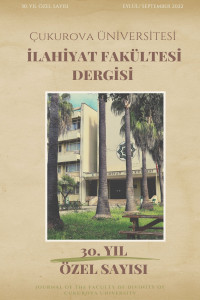“Mâturîdî’nin Te'vilat‟Inda Sarf Sigalarinin Semantik Değişimi Olgusu
Bu çalışmanın amacı, İmam Ebû Mansûr Muhammed b. Muhammed b. Mahmûd el-Mâtürîdî’nin (ö333.) “Te‘vilâtu’l-Kur’ân” isimli tefsirinde sarf sîgalarının semantik değişimi olgusunu nasıl ele aldığını ve Kur’ân âyetlerinin anlamlarını bu olguya göre tefsir ederken, bu olguya nasıl dayandığını göstermektir. Bu çalışmanın yöntemi, İmam Mâtürîdî’nin “Te‘vilâtu’l-Kur’ân” tefsirinde bu olguya dayandığı yerleri tespit etmek ve daha sonra onun görüşünü lugat ve tefsir âlimlerinin görüşleriyle karşılaştırmaktır. Bu karşılaştırmanın amacı İmam Mâtürîdî ile diğer âlim ve müfessirlerin benzerliklerini ve farklılıklarını ortaya koymaktır. Ayrıca bu çalışmanın özellikle odaklandığı konulardan biri de İmam Mâtürîdî'nin bazı Kur‘ân ayetlerini sarf sîgalarının semantik değişimi olgusuyla uyumlu olarak yorumlamasıdır. Çünkü bu dil olgusunu içeren Kur’ân âyetlerinden bazıları, bu dil olgusunun neden olduğu bir sorun olarak ortaya çıkmıştır. Bu nedenle İmam Mâtürîdî bazı Kur’ân âyetlerinin tevilinde Arapların üslubundan ayrılmayacak şekilde bu olguya dayanmıştır.
Anahtar Kelimeler:
Arap dili, Semantik değişimi, Sîgaların delâletleri, Te‘vilâtu’l-Kur’ân, Mâtürîdî
The Phenomenon of The Rotation of the Morphological Forms in “Taʼwīlāt al-Māturīdī”
This study aims to reveal the phenomenon of alternating semantics of morphemes in al-Māturīdī. Because this phenomenon has a significant impact on the interpretation of the Qur’an. The purpose of this study is to show how al-Māturīdī dealt with this phenomenon in his interpretation and how he relied on it in extracting the meanings of the Qur’anic verses and their interpretation in accordance with this phenomenon. The method of the study was to extrapolate the author of al-Māturīdī and observation the places in which he relied on this phenomenon in his interpretations, and then compare between what he said of the opinion on this place and the linguists and other interpreters to reveal the extent of compatibility between him and them. One of the things that this study tries to find is the reason why al-Māturīdī interpreted some Qur’anic verses in accordance with this phenomenon. Because some of the verses of the Qur’an have emerged as a problem caused by this language phenomenon. For this reason, Imam al-Māturīdī relied on this phenomenon to interpret the verses of the Qur’an in a way that would not deviate from the Arabic expression.
Keywords:
Arabic language, Semantic Alternation, Meanings of the morphemes, Taʼwīlāt al-Qurʼān, al-Māturīdī,
___
- Brockelmann, C. (ty.) Fıḳhü'l-luġāti's-Sâmiyye. (terc: Ramadân Abdüttevvâb). Câmiatü’-Riyâd li’l-Memleketi’l-‘Arabiyyeti’s-Suûdiyye.
- Ebû Bekâ el-Ukberî. (1979). İmlâʾü mâ menne bihi’r-raḥmân. Beyrut: Dâru’l-Kütübi’l-İlmiyye.
- Ebû Hayyân Muhammed Esîruddîn el-Endelûsî. (1998). İrtişâfu’d-darb min lisânu’l-‘Arab. (thk.: Recep Osman Muhammed). Kahire: Mektebetü’l-Hâncî.
- Ebû Hayyân Muhammed Esîruddîn el-Endelûsî. (h. 1420). el-Bahru’l-muhît fi’t-tefsîr. (thk.: Sıdkî Muhammed Cemîl). Dâru’l-Fikr.
- el-Ezherî, Muhmmed. (2001). Tehzîbu’l-luga. (thk. Muhammed İvaz Mu‘rib). Beyrut: Dâr-u İhyâi't - Turâsi'l – ‘Arabî.
- el-Ferrâ, Zekeriyye. (ty.). Me‘âni’l-Kur’ân. (thk: Ahmed Yusuf en-Necâtî vd.). Dâru’l-Mısriyye li’t-Te’lîf ve’t-Terceme.
- İbn Atiyye, Muhammed ‘Abdulhakk. (h. 1422) el-Muharraru’l-vecîz. (thk: Abdüsselam eş-Şâfî). Beyrut: Dâru’l-Kütübi’l-İlmiyye.
- İbn Cinnî, Osmân. (ty.). el-Hasâis. Mısır: el-Hey’etü’l-Mısriyye. el-‘Âmme li’l-Kitâb.
- İbn Düreyd, Muhammed b. el-Hasen. (1958). el-İştikâk, (thk: Abdüsselam Harun). Kahire: Mektebetü’l-Hâncî.
- İbn Fâris, Ahmed. (ty.). eṣ-Ṣâḥibî fî fıḳhi'l-luġa. (thk: Ahmed Sakar). Matbaatü Îsâ el-Bânî el-Halebî.
- İbn Sîde el-Mursî. (1996). el-Muhassas. (thk.: Halil İbrahim Cefâl). Beyrut: Dâr-u İhyâi’t-Turâsi’l-‘Arabî.
- İbnü’l-Esîr, Nasrullâh. (h. 1420). el-Mes̱elü’s-sâʾir fî edebi’l-kâtib ve’ş-şâʿir. Beyrut: el-Mektebetu’l-‘Asriyye.
- Kâdî, Abdulcebbâr. (1969) Müteşâbihü'l-Kur'ân. (thk.: A. Zerzûr). Mısır: Dâru't-Turâs.
- el-Mâturîdî, Ebû Mansûr Muhammed. (2005). Tefsîru’l-Mâturîdî te’vîlât-u ehli’s-sünne. (thk.: Mecdî Baslûm). Beyrut: Dâru’l-Kütübi’l-İlmiyye.
- en-Nehhâs, Ahmed b. Muhammed. (h. 1421) İ’râbu’l-Kur’ân. (thk: ‘Abdülmün’im Halîl). Beyrut: Menşûrât Muhammed ‘Alî Beydûn, Dâru’l-Kütübi’l-İlmiyye.
- en-Nîsâbûrî, Muhammed. (1995). İ’câzu’l-beyân an me‘âni’l-Kur’ân. (thk: Hanîf b. Hasen el-Kâsımî). Beyrut: Dâru’l-Ğarbi’l-İslâmî.
- Razi, Fahruddîn. (h. 1420). Mefâtîhul-gayb. Mısır: Dâr-u İhyâi’t-Turâsi’l-‘Arabî.
- es-Seâlibî, Ahmed. (2002). Fıkhu’l-luğa ve sirru’l-‘Arabiyye. (thk: ‘Abdürrezzak el-Mehdî). Mısır: Dâr-u İhyâi’t-Turâsi’l-‘Arabî.
- Semîn el-Halebî, Ahmed. ed-Dürru’l-masûn fî ‘ulumi’l-kitâbi’l-meknûn. (thk.: Ahmed Muhammed el-Harrâd). Dımeşk: :Dâru’l-Kalem.
- Sîbeveyh, ‘Amr b. ‘Usmân. (1988). el-Kitâb, (thk.: ‘Abdusselâm Hârûn). Kahire: Mektebetü’l-Hâncî.
- Şahin, Abdüssabur. (1980). el-Menhecü'l's-savti. Beyrut: Müessesetü’r-Risâle.
- ez-Zeccâc, İbrâhîm. (1988). Meâni’l-Kur’ân ve i’râbuhu. (thk.: ‘Abdulcelîl ‘Abduh Şiblî). Beyrut: ‘Alemü’l-Kütüb.
- ez-Zemahşerî, Cârullâh. (h. 1407). el-Keşşâf ʿan ḥaḳāʾiḳı ġavâmiżi’t-tenzîl ve ʿuyûni’l-eḳāvîl fî vücûhi’t-teʾvîl. Beyrut: Dâru’l-Kitâbi’l-‘Arabî.
- Yayın Aralığı: Yılda 2 Sayı
- Başlangıç: 2001
- Yayıncı: Çukurova Üniversitesi
Sayıdaki Diğer Makaleler
FATİH YAHYA AYAZ, MAKRÎZÎ; SİYERİN ÖNCÜLERİ, SİYER YAYINLARI, İSTANBUL 2021, 126 SAYFA.
VEZÎR EL-MAĞRİBÎ VE “SİYASET ÜZERİNE” ADLI ESERİ: ANALİZ VE ÇEVİRİ
Nail KARAGÖZ, Ayturgan AVAZBEK KIZI
OSMAN NURİ ERGİN’İN ÇALIŞMALARINDA BAHÂÎLİK HAREKETİ
KIRÂAT FARKLILIKLARININ MEALE YANSITILMASI - MUSTAFA ÖZTÜRK VE KUR’AN-I KERİM MEALİ ÖRNEĞİ
DİJİTAL DÜNYADA TESELLİ ARAMA: DİNİ BAŞA ÇIKMA ARAÇLARININ SOSYAL MEDYADA KULLANIMI
“Mâturîdî’nin Te'vilat‟Inda Sarf Sigalarinin Semantik Değişimi Olgusu
MODERN PSİKOLOJİDE VE KLASİK İSLAM DÜŞÜNCESİNDE ÜZÜNTÜ DUYGUSU: KİNDÎ ÖRNEĞİ
